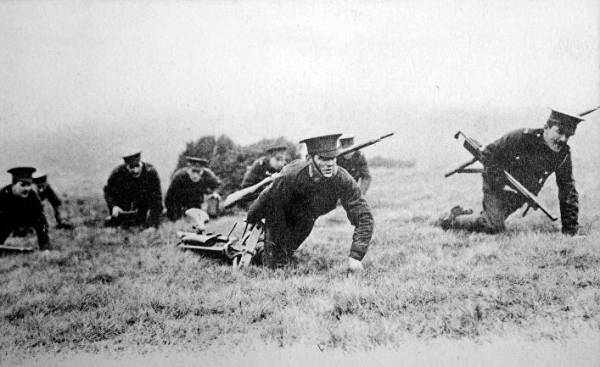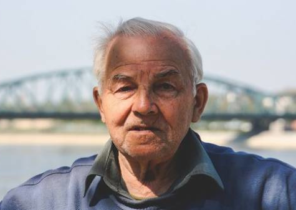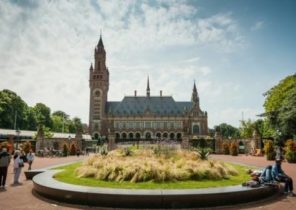
The first world war took place 100 years ago, and the battle of the Somme, at Verdun and in Flanders was a place of unbearable suffering. It’s hard to understand today, when you walk through the green fields of France and Belgium.
Was about half past seven in the morning, when the corporal Arthur cook (Arthur Cook) and his comrades from the 1st battalion light infantry Somerset climbed out of their trenches and went straight into a cloud of lead the German machine guns.
The first world war (1914-1918)
The war began in the late summer of 1914, when the Austro-Hungarian throne, Franz Ferdinand (Franz Ferdinand) was assassinated in Sarajevo.
During the war the allies France, UK, Russia and Italy fought with the great powers Germany, Austria-Hungary and Turkey.
Later entered the war several countries, particularly the US, which joined the allies in 1917.
The war was worldwide, but the most important fighting took place on the Western front. Here the parties stood against each other in the trenches, which extended in a continuous line through Belgium and France from the Pas-de-Calais to the Swiss Alps.
The first world war cost the lives of roughly 11 million soldiers and 7 million civilians.
The British have already seen that the soldiers of the first wave of the attack was struck by an opponent, about whom they said he was destroyed by artillery strikes last week.
With adrenaline in the blood of the soldiers of the battalion of the Somerset have experienced fear and impatience, awaiting the signal to attack.
“With prayer we got out of the trenches, but go far could not, because the strip of land we came under fire from machine guns. Guys started dropping like flies, but we were forced to proceed. First was killed the Lieutenant, then his Deputy. Just five minutes after the attack began I was in charge of a Department,” wrote Arthur cook later in his diary of July 1, 1916.
Today, everything breathes peace and quiet. But one hundred years ago, quiet forests and beautiful fields of France and Belgium was hell on earth, where gas attacks, artillery shells, and the putrid smell was the everyday life of millions of German, French and British soldiers who fought and died on the Western front.
Unlike many of his comrades he survived that day, the first day of the battle of the Somme, which lasted four months. The British losses as of July 1, amounted to 20 thousand in killed and 77 thousand wounded. At that moment it was the bloodiest day in the history of the British army.
When in November was quiet battles, the loss amounted to 400 thousand soldiers, it was the price for what they were able to push the Germans 8 miles.
The field was a border area of the Kingdom of death, where there was a thick stench of decay and the smell of gunpowder
The battle of the Somme later gained mythological status in the UK and its allies, particularly in Canada, Australia and New Zealand. She became a symbol of the First world war, when millions of young people for four years fought and died in trenches full of mud and rats, a continuous line stretching from Pas-de-Calais to the Swiss Alps.
Thousands of people died for every kilometer of reclaimed.
Memorial Park returns us to the past
Endless tourists from the former British Empire every year visit the battlefields of the Somme to the North-East from Amiens in France and in the Western Belgian region of Flanders. They come mainly to inspect the places where their relatives during the war, fought and often in the same place and were buried. For this reason, especially in Flanders, the locals speak good English.
In the Newfoundland memorial of beaumont-Hamel the fragments of the battlefield. You go in the trenches where the soldiers slept, smoked and made fun of each other. On the field in front of the trenches you stand on the spot where many of them died.
Most of the trenches have long been plowed and turned back into the fields, where the locals are constantly finding unexploded shells, fragments of military equipment and the remains of the soldiers who fought here about 100 years ago. They are based on some of the many soldier cemeteries of the war.
At beaumont-Amalia of the Somme still remains something from the field of battle. Soldiers from Britain and Newfoundland of July 1, was to attack the Germans, were just a few hundred metres from Arthur cook and the soldiers of the battalion of Somerset, and they had the same terrible day. Of the 780 men of the Newfoundland, on their way to attack, by nightfall the survivors were only 110.
Already in 1925 a memorial was erected to Newfoundland. The statue depicts a deer standing on hill and looking in the direction of the attack, where the bottom is still visible craters from shells and the remains of trenches, where the people lived.
When you stand at the top and inspect the place where 101 years ago there was fierce fighting, it is not necessary to possess rich imagination to imagine the historical events that happened here.
So you get to the front
Local travel agencies can offer you brochures and maps and advise what is worth a look. In addition, they have employees who can go with you as guides. Thus you will get the opportunity to enrich their knowledge about the battles, the soldiers and terrain.
Hire a car and begin their own investigation. With little historical information, and a map, you can make quite a big trip and to have freedom of choice. Because the battlefields are scattered around over a large area, public transport is not very convenient solution.
Pick up the bike. Especially in Flanders and the Somme area convenient for Cycling. Here are many ways by which you should try to ride. So you will have an active and informative holiday.
The city of albert is located very near the old front line on the Somme, it has restaurants, stay the night and a number of museums dedicated to the war.
Verdun is a beautiful city, which in itself deserves to visit it. Because it is convenient to visit places of fighting battles that took place around the city because it is located in the Central part of the area.
Ypres. The spelling of this place name has two forms and depends on you speak Flemish or French. On behalf of the city and named the section of the front around it. In this and the surrounding areas many attractions.
There is the first line of trenches, where the soldiers bent down with each burst of a shell and nervously waiting for the signal to attack, which sent them to their deaths. Today it is a hole in a field, around which you can walk.
When sounded the signal to attack, the soldiers got up and moved forward on the strip of land on the German line of trees, from which swept a deadly machine-gun fire that killed young soldiers like a sharp sickle mows wheat in a field.
A deep hole in the meadow, which at the time was no man’s land, mark the places where the shells exploded and sent red-hot twisted pieces of metal into the bodies of people who were around the blast site.
Hell turned into the idyll
In the last episode of the British Comedy series “Blackadder Goes Forth”, which is set during the First world war, to begin a large attack to “field Marshal Douglas Haig (Douglas Haig) was able to move his cocktail bar six inches closer to Berlin”, as remarked dryly captain Blackadder (Rowan Atkinson, Rowan Atkinson).
In the final scene, he and his colleagues get out of the trench and running forward to the enemy through the explosions and fire. Hell gradually turns into a blooming field of poppies on a Sunny summer day, a very moving final scene in General ironic and entertaining serial movie.
Each year, the earth there are tons of remnants of war. This can be anything from a small steel bullets, machine guns and helmets to unexploded ordnance. And these shells sometimes lead to fatalities.
This scene brilliantly sums up the feelings that arise in you when you walk through the Memorial to the Newfoundland. Everywhere you feel the presence of history, because traces of it are literally in front of your eyes.
However, it is difficult to imagine that this beautiful and peaceful place where the sun shines, the birds chirp and the breeze plays with long grass, was a place of incredible amount of death and suffering. The field was a border area of the Kingdom of death, where there was a thick stench of decay and the smell of gunpowder, the ground was strewn with dead and wounded. A sound background was a mixture of shouts, bursts of gunfire and exploding shells, transforming the land into a moonscape pitted with craters like the marks of smallpox, without any trees.
The contrast between the hell of 1916 and the present mood of the idyll visible from the Somme everywhere, primarily in the cemeteries, filling the soft North French landscape.
Trenches and shell craters in the fields of Northern France, the Somme tell about the battle in which for every meter conquered territory was killed or injured thousands of soldiers. Although it’s been 100 years, it remains in the historical memory of the country.
Large museums in Péronne and the great monuments in Thiepval and Longewala brilliantly explain and show the different aspects of the battle.
In forest areas such as Delvil wood, Bazentin and Mametz the plow of the farmer spared the battlefield. They are open to visitors, which, nevertheless, urge not to dig about metal objects on the ground, if they don’t want to suffer the same fate as many soldiers, that is to be torn to pieces, “blown to bits” as the English say, and thus to add to the list of military losses with a delay of 100 years.
For, unfortunately, neglected German cemetery at Mikura, lie buried about 17 thousand soldiers in a simple environment without flags or monuments that clearly shows who lost in this war.
Among them are the Danish inhabitants of South Jutland, who were forced to serve in the German army and never returned home.
The slaughter at Verdun
At the same time, when was the battle of the Somme, a couple of hundred kilometers to the South there was a desperate scramble in the area around the French city of Verdun. In February 1916 the Germans attacked the station to its knees the French army. When in December, the fighting here was quiet, it was estimated that in this battle were killed, wounded or missing one million French and German soldiers. But the front line remained roughly the same as it was 10 months before the start of the fighting.
For the duration of the battle, a large number of the soldiers participating in it on both sides and appalling conditions in which soldiers had to keep fighting, the battle of Verdun became a French symbol of war, national trauma, is filled with myths and influencing the life of the country over the next decades.
“Verdun was a battle of artillery fire which was so intense that the trenches in the end just disappeared. The soldiers lived in the craters from shells, which were fully around,” says the guide, Vincent (Vincent), when we drive in his car on the road, winding along the slopes of the local hills covered with forest.
But after a short ride further South, we find these trenches at Saint-Miela and Les Aporia.
When in 1918 the guns fell silent, large areas of France and Belgium was completely destroyed by the war. Across the country the French army for a year permanently removes over 40 tons of unexploded ordnance.
“The earth was so filled with corpses that it was impossible anywhere to start digging without bumping into one of them.”
Vincent, the guide of Verdun.
As I learned, at this speed the removal of munitions in the area, France will be cleared in about 500 years. In most areas, however, there is no more ammunition, but in the so-called red zone around Verdun find them constantly.
Unlike the Somme, here at Verdun, it was decided to retain the field of battle. This was done to pay tribute to the victory over Germany, inherited a great price. In addition, the earth is still so many corpses and unexploded ordnance, which in many places even it is impossible to use the compass because of the abundance of iron in the ground. It was decided to fill the area by planting trees, which will preserve it for posterity.
Many of the millions of victims of the war and were not buried. Some were literally blown to thousands of pieces of artillery shells, while others are buried under the cover of green grass in various places in France and Belgium. The only memory about them is the name on the monuments of soldiers and in the minds of their loved ones.
When climb up on some hill under Tiaminom, the land around looks like Swiss cheese due to the large number of small and large craters from artillery shells. If you remove the trees, you know the old paintings of the battle, when the soldiers clung to life, escaping in these craters.
Says Vincent, it was hell, consisting of mud, shit and death.
“The earth was so filled with corpses that it was impossible anywhere to start digging without bumping into one of them. In the colder months, soldiers were constantly wet and cold, and in summer suffering from thirst and disease, because the fresh water they were brought up rarely. Desperation forced soldiers to drink a stinking liquid accumulated at the bottom of craters. And all this time the artillery continued to kill and maim people left and right,” he says.
That’s why front-line infantry units most of all tried to get water together with tobacco and hand grenades when they installed the connection with the main headquarters in the rear.
At the front the mud was one of the conditions of life of soldiers and one of those dangers which they feared the most, because he could drown in deep mud on the battlefield. It seems quite realistic, as there is evidence of this.
3 events in Flanders
1 Memorial Museum, Passendale 1917
The Museum is surrounded by a beautiful Park in Zonnebeke, acting on your feelings, you feel the smells and hear the sounds, the Museum brilliantly tells the story of the battle. There is even a reconstructed trenches and bomb shelters in the ground that allow you to be a soldier. In connection with the centenary of this battle is named after the Museum it hosts various events, which will continue in the coming months.
2 The Last Post at the gate Meninska
Every evening at 20.00 at the gate Meninska in the centre of Ypres is the trumpet played “The Last Post” to commemorate the many thousands of soldiers who died here in 1914-18 year. Except during the German occupation of the country during the Second world war, this happens since 1928, every evening, despite the rain, sleet or mud.
3 Military cemetery, Tina the cat
After only two days, after Australian soldiers in October 1917 seized the former German strong point, here were buried the first soldiers. Today here are 11 965 soldiers, most of which is still unknown. Here is a memorial wall with the names of 34 887 soldiers of great Britain and New Zealand, which was missing.
“After the war many veterans have not been able to sleep in the bed because the mattress was too soft. In a nightmare they saw themselves on the back blending into the dirty swamp and shouting woke up in the night. To the end of their lives, they carried the horrors of war,” says Vincent.
Friend and foe lie together
In the red zone around Verdun are nine villages, which during the battle, “died for France” and was completely destroyed. One of them is called Fleury. Just a couple of months it passed from hand to hand, about 60 times, there is not a single building.
Signs that are installed around between the trees, take note of those places, where before the war there were houses, a forge and a bakery.
In the summer of 1916 Fleury was one of the most dangerous places on earth, where you at any moment could break into pieces, or you could die from choking in a cloud of poison gas.
When out of the ground in the local woods and fields, new bone, stacked in the crypt together with those that are already there.
But today the biggest danger here is ticks, which you can dial, walking in the tall grass between the trees. Here today to hear the German language no longer means that you are exposed to in the head a hand grenade, it’s just a group of tourists.
In the middle of the trail lies a large bone, Vincent believes that it’s the bone of a horse. There is nothing unusual in that here forest land appear the bones of people and animals. They are placed on the trail, after which they engaged the local authorities.
In another part of the field of battle, near the ruins of Fort Duomo is the most beautiful cemetery in the area. The remains of approximately 146 thousand French and German soldiers are buried here in a gigantic vault, which rises above the cemetery. Most of them have no name. They are victims of industrial carnage, where the soldiers have ceased to be individuals.
During the battle of Verdun in Fort Duomo exploded several million shells of large and small caliber.
When out of the land of forests and fields there are new bones, pile them in the crypt together with those that are already here. Whether they are German or French, it won’t matter. Friend and foe lie together side by side.
Reconciliation permeates Verdun, where French and German flags waving along with the EU flag. Prior to this crypt under Dwamena, the resting place of so many soldiers of the two countries, the state leaders of Germany and France, Helmut Kohl (Helmuth Kohl) and Francois Mitterand (François Mitterand) in 1984 stood together in front of journalists from around the world.
Along with them stood the veterans of both sides, who were initially reserved, but then they hugged, with tears in his eyes.
The message was clear: reconciliation, cooperation and friendship will never repeat the hell of the Western front.






